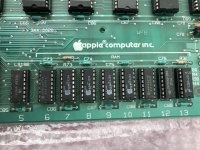So, I was given a whole bunch of Apple stuff recently. I have three monitors (Apple Color Composite IIe, Apple Green Phosphor and an Amdek amber monochrome), two Apple IIe Enhanced systems, an Apple IIc (no power pack yet), two dual disk drives (no cables yet), two single disk drives and a bunch of assorted cables and software (Oregon Trail... because, what else would people have??).
So far I've cracked open the power supplies in both IIe systems and replaced the Rifa X caps, and I've tested the two Apple monitors and two single disk drives. Everything works except that I get garbage on the screen on both IIe systems. I also get some odd issues when trying to view or edit the top-ten in Oregon Trail. The game itself works great from start to finish.
Also, when I try to use http://asciiexpress.net/diskserver/ from my iPad to either IIe system I can get Insta Disk to load, but I get "Disk Error" immediately when formatting or writing, without it ever even spinning the disk up to do anything. I'm using unused DD disks. I don't think it's the disks or the drives.
I have noticed that the garbage on the screen happens much more frequently with the IO interface card (for the disk drive) inserted. When I take it out, it more commonly when reach the prompt without garbage on the screen.
Also, when I switch off the power the same garbage is still on the screen when I switch the power back on, usually with some different characters scattered in. One time when it kept showing garbage, so I switched it off and on a few times in quick succession (a couple seconds apart), then it slowly typed out "SYNTAX ERROR IN 57088". I switched it off and on again and the message switched to "SQNTAP ERROR IN 57088" and then, after doing it again "6RPNTAP DRRNR @F....". Kind of funny, but quite mystifying.
Here are some pictures of the errors and the types of garbage I get on the screen. Both have very similar problems
I have tried reseating most of the socketed chips. I have also run the self diagnostic and it passed with "System OK". Both systems play Oregon Trail perfectly, but both crash with an "Error 53 at line #41000" when showing the top ten scores.
Here's a gallery with some pictures of the errors, and showing the game working.
https://photos.app.goo.gl/mYhcTeKMU6EEHbwr9
I can diagnose things to some degree, but I have no idea where to start with this. I'm an IBM\PC guy mainly... this is the first time I've played with an Apple II since I was in grade school in the early '90s.
Any help is much appreciated.
So far I've cracked open the power supplies in both IIe systems and replaced the Rifa X caps, and I've tested the two Apple monitors and two single disk drives. Everything works except that I get garbage on the screen on both IIe systems. I also get some odd issues when trying to view or edit the top-ten in Oregon Trail. The game itself works great from start to finish.
Also, when I try to use http://asciiexpress.net/diskserver/ from my iPad to either IIe system I can get Insta Disk to load, but I get "Disk Error" immediately when formatting or writing, without it ever even spinning the disk up to do anything. I'm using unused DD disks. I don't think it's the disks or the drives.
I have noticed that the garbage on the screen happens much more frequently with the IO interface card (for the disk drive) inserted. When I take it out, it more commonly when reach the prompt without garbage on the screen.
Also, when I switch off the power the same garbage is still on the screen when I switch the power back on, usually with some different characters scattered in. One time when it kept showing garbage, so I switched it off and on a few times in quick succession (a couple seconds apart), then it slowly typed out "SYNTAX ERROR IN 57088". I switched it off and on again and the message switched to "SQNTAP ERROR IN 57088" and then, after doing it again "6RPNTAP DRRNR @F....". Kind of funny, but quite mystifying.
Here are some pictures of the errors and the types of garbage I get on the screen. Both have very similar problems
I have tried reseating most of the socketed chips. I have also run the self diagnostic and it passed with "System OK". Both systems play Oregon Trail perfectly, but both crash with an "Error 53 at line #41000" when showing the top ten scores.
Here's a gallery with some pictures of the errors, and showing the game working.
https://photos.app.goo.gl/mYhcTeKMU6EEHbwr9
I can diagnose things to some degree, but I have no idea where to start with this. I'm an IBM\PC guy mainly... this is the first time I've played with an Apple II since I was in grade school in the early '90s.
Any help is much appreciated.

